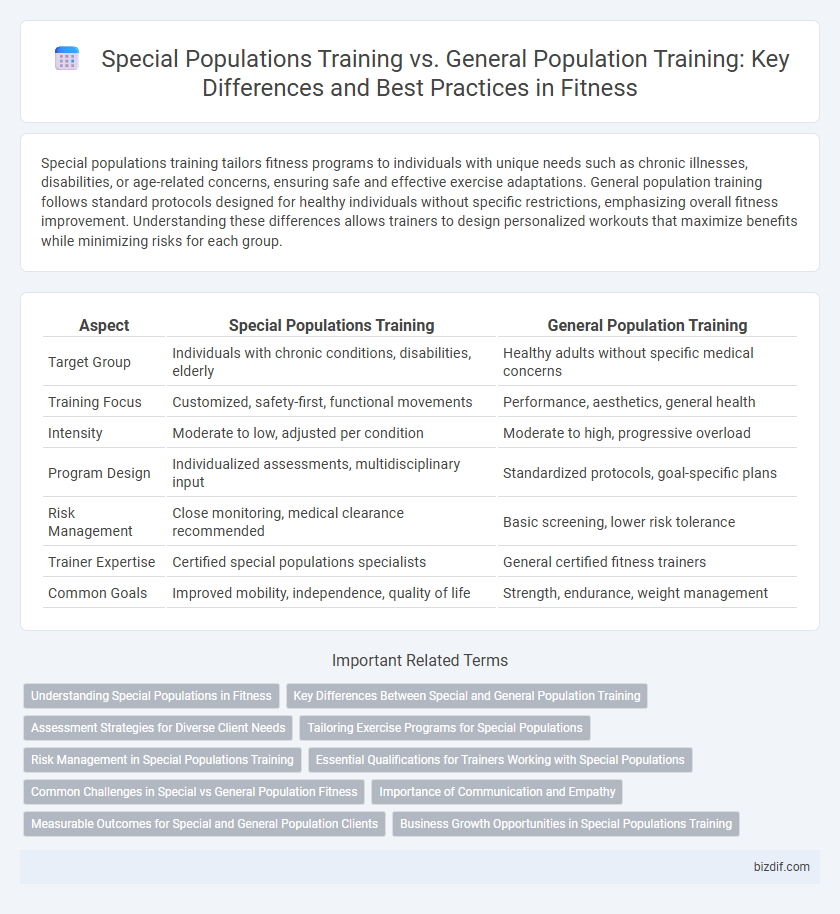Special populations training tailors fitness programs to individuals with unique needs such as chronic illnesses, disabilities, or age-related concerns, ensuring safe and effective exercise adaptations. General population training follows standard protocols designed for healthy individuals without specific restrictions, emphasizing overall fitness improvement. Understanding these differences allows trainers to design personalized workouts that maximize benefits while minimizing risks for each group.
Table of Comparison
| Aspect | Special Populations Training | General Population Training |
|---|---|---|
| Target Group | Individuals with chronic conditions, disabilities, elderly | Healthy adults without specific medical concerns |
| Training Focus | Customized, safety-first, functional movements | Performance, aesthetics, general health |
| Intensity | Moderate to low, adjusted per condition | Moderate to high, progressive overload |
| Program Design | Individualized assessments, multidisciplinary input | Standardized protocols, goal-specific plans |
| Risk Management | Close monitoring, medical clearance recommended | Basic screening, lower risk tolerance |
| Trainer Expertise | Certified special populations specialists | General certified fitness trainers |
| Common Goals | Improved mobility, independence, quality of life | Strength, endurance, weight management |
Understanding Special Populations in Fitness
Special populations in fitness include individuals with chronic conditions, disabilities, older adults, and pregnant women, requiring tailored training programs to address their unique physiological and functional needs. Understanding these populations involves assessing limitations, adapting exercises for safety, and focusing on improving quality of life through customized interventions. Incorporating evidence-based strategies ensures effective progression while minimizing injury risk compared to general population training.
Key Differences Between Special and General Population Training
Special Populations Training addresses unique needs of individuals with chronic diseases, disabilities, or age-related conditions, requiring tailored exercise regimens to improve safety and efficacy. General Population Training follows standard protocols aimed at overall fitness and performance without specific medical considerations. Key differences include individualized assessments, modified intensity, and specialized equipment to accommodate physical limitations in special populations.
Assessment Strategies for Diverse Client Needs
Assessment strategies for special populations training prioritize comprehensive health screenings, functional movement analyses, and tailored risk stratification to address unique medical conditions and physical limitations. In contrast, general population training often relies on standardized fitness tests focusing on overall strength, endurance, and flexibility to establish baseline performance. Customized assessment protocols for diverse client needs ensure safe, effective programming, optimizing outcomes while minimizing injury risks.
Tailoring Exercise Programs for Special Populations
Tailoring exercise programs for special populations requires a comprehensive understanding of unique health conditions such as cardiovascular disease, diabetes, or mobility impairments to ensure safety and effectiveness. Specialized training protocols emphasize modified intensity, frequency, and exercise selection to address individual limitations and promote functional improvements. Unlike general population training, this approach prioritizes personalized assessments and adaptive strategies to optimize health outcomes and prevent injury.
Risk Management in Special Populations Training
Risk management in special populations training involves thorough health screenings, personalized program design, and continuous monitoring to prevent injury and accommodate chronic conditions such as diabetes, cardiovascular disease, and arthritis. Trainers implement modified exercise protocols and closely track physiological responses to ensure safety and efficacy. This targeted approach contrasts with general population training, which typically follows standardized routines with less intensive individual risk assessment.
Essential Qualifications for Trainers Working with Special Populations
Trainers working with special populations must possess certifications such as the American College of Sports Medicine (ACSM) Certified Exercise Physiologist or the National Academy of Sports Medicine (NASM) Special Population Specialist credential to safely design and implement tailored fitness programs. Knowledge of medical conditions like cardiovascular disease, diabetes, and orthopedic limitations, combined with skills in adaptive exercise techniques and risk management, is essential to ensure effective and safe training. Proficiency in conducting pre-participation health screenings and collaborating with healthcare professionals further distinguishes special populations trainers from those working exclusively with the general population.
Common Challenges in Special vs General Population Fitness
Special populations in fitness training face unique challenges such as chronic illnesses, mobility issues, and age-related limitations that require tailored exercise programs to ensure safety and effectiveness. In contrast, general population training typically focuses on performance, endurance, and aesthetic goals without the need for extensive modifications. Addressing these distinct needs involves specialized knowledge in pathology, risk management, and adaptive exercise techniques to optimize outcomes for individuals with special conditions.
Importance of Communication and Empathy
Effective communication and empathy are crucial when designing fitness programs for special populations, ensuring exercises accommodate unique physical and emotional needs. Trainers must listen actively and adapt language to foster trust and motivation, enhancing program adherence and safety. Understanding client-specific challenges allows for personalized instruction that improves outcomes compared to general population training approaches.
Measurable Outcomes for Special and General Population Clients
Special populations training emphasizes individualized program design targeting specific health conditions, leading to measurable improvements in functional capacity, mobility, and quality of life metrics. General population training prioritizes broad fitness goals such as strength, endurance, and body composition with quantifiable outcomes like increased VO2 max, muscle hypertrophy, and weight loss. Tracking progress through validated assessments ensures tailored adaptations and objective evaluation of client improvements in both groups.
Business Growth Opportunities in Special Populations Training
Special populations training offers significant business growth opportunities by catering to niche markets such as seniors, individuals with chronic illnesses, and those undergoing rehabilitation, which are often underserved in the fitness industry. Tailored programs that address specific health conditions and mobility limitations increase client retention and allow trainers to charge premium rates. Expanding services to include special populations enhances brand differentiation and opens avenues for partnerships with healthcare providers and rehabilitation centers.
Special Populations Training vs General Population Training Infographic

 bizdif.com
bizdif.com